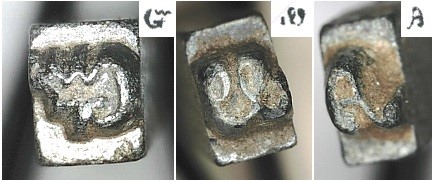Teka R. McGlothlin, Arkansas Archeological Survey
Artifact of the Month - January 2019

Of the many artifacts recovered in 2012 from a now defunct homestead in Cane Hill were pieces of type such as those used in printing presses to print reading materials. The uniqueness of this type resides in the fact the characters are those from the Cherokee Syllabary dating around the 1840s, and only 6 distinct sets of Cherokee syllabary type have been verified at this time. The finding of these pieces along with written historical accounts allowed us to breathe life into these artifacts from an archeological perspective.
A total of 14 type keys were found, some with clearly legible characters, some broken, and some blank which would have been used as spacers when typesetting. These type keys are made of a composite metal containing lead, tin, and antimony, and measure approximately 9/16” long, 1/8” wide, and 5/32” high. Of the type, three are distinctly characters of the Cherokee Syllabary, which was developed in the early nineteenth century by Sequoyah, inventor of the Cherokee “alphabet,” and adapted by Elias Boutinot, “editor of the first American Indian newspaper, the Cherokee Phoenix,” (Cushman 2011:113) for use in the printing press. The introduction of the Cherokee Syllabary allowed the printing of newspapers and translations of European works such as the Bible into the Cherokee language. As such, the syllabary factored into Cherokee educational practices and is still in use today.

Given the vicinity of Cane Hill to Indian Territory, it is no surprise there was interaction between the citizens of Cane Hill and the Native Americans through trade and business. This is evident in the historic record, particularly “The Life of Preston B. Plumb 1837–1891,” in which William Connelley recounts a printing press “had been in use in the Cherokee Nation, and was sent to Cane Hill when the war began (Connelley 1913:126).” According to him, the press was acquired by Reverend Jones, a Baptist missionary located a few miles west of Cincinnati, Arkansas, for use in the education of the “Pin” Indians, and operated to print Bibles in the Cherokee language. Later the press would come to Cane Hill in lieu of debts owed by Reverend Jones at the beginning of the war (Connelley 1913).
In the fall of 1862, as the Union soldiers marched into Cane Hill to engage the Confederate forces, a group of Union soldiers, including Major Preston Plumb of the Eleventh Kansas, encountered printing equipment and type in “a small printing office in a log cabin at the edge of the town” (Connelley 1913:126). These accounts indicate the discovered press included both English and Cherokee characters which were scattered, or pied, upon discovery. Coming from printing backgrounds themselves, some of the men opted to take advantage of the discovered press in their idle hours and gathered the strewn pieces. With this new discovery, these individuals proceeded to produce a Union propaganda paper named The Buck and Ball.
Although there is no doubt of the biased attributes of this publication, it provides invaluable insight into the events of the Civil War in the Ozarks, particularly in Northwest Arkansas and Cane Hill. Accounts included in this paper mention how its publication was interrupted in order for the “publication staff” to march to and fight in the Battle of Prairie Grove. One compelling aspect about this paper is the fact that after this horrific battle, the men returned to Cane Hill to pick up the publication where they had left off. The results of this leave immediate accounts and sentiments both before and after the engagement of Prairie Grove by the Union troops. The discovery of these pieces of type, along with other Civil War related artifacts such as a Union Eagle button and .69 caliber Minie balls, indicate the likely presence of Union soldiers at the site either before or after the engagement of Prairie Grove, if not both.

* * *
Materials: composite metal containing lead, tin, and antimony
Dimensions: 9/16” long, 1/8” wide, and 5/32” high
Age Estimate: 178 +/- years
